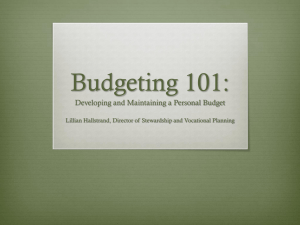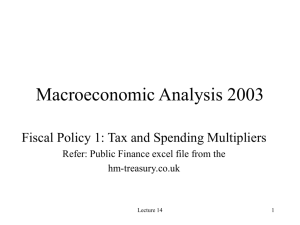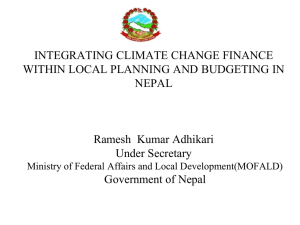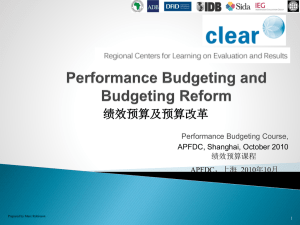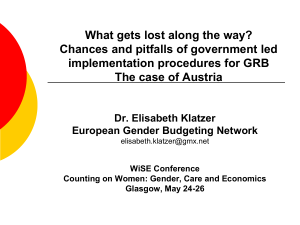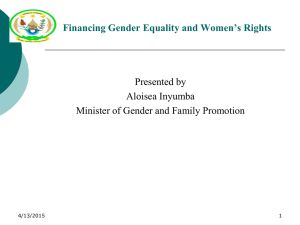What do we want? A feminist economic strategy? When do we want
advertisement
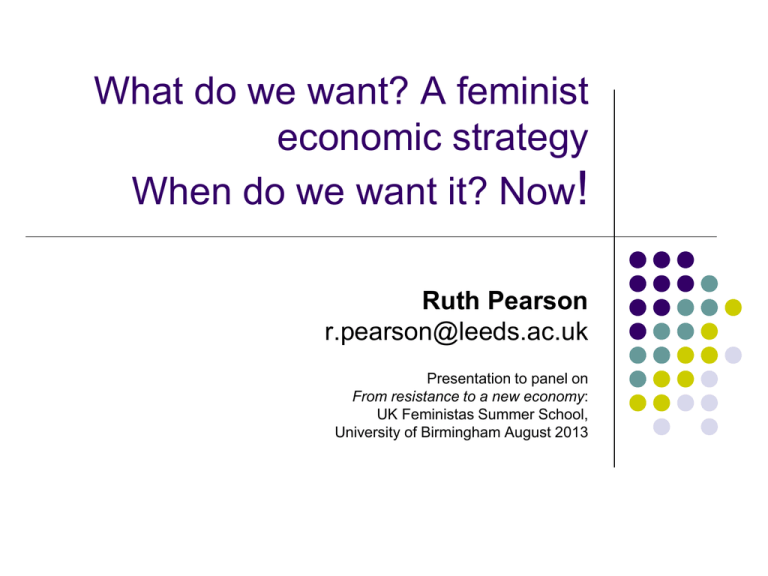
What do we want? A feminist economic strategy When do we want it? Now! Ruth Pearson r.pearson@leeds.ac.uk Presentation to panel on From resistance to a new economy: UK Feministas Summer School, University of Birmingham August 2013 There is an alternative! A Feminist Economics Approach Need to challenge the idea that there is no alternative to the cut welfare and public spending/ reduce wages and national debt approach of current government (and others) Feminist economics offers a different perspective – prioritises the reproductive economy, not the financial (neo-classical) or productive ( post) Keynesian approach Rethinking the economy Conventional economics concerned with financial flows and balances – taxation, spending, international trade, deficit and debt And assumes that growth in the GDP is the holy grail of economic achievement; Fem econs are concerned with the (re)production of people and wellbeing - not just labour power Investing in the social approach – to invest in the social infrastructure (care, multigenerational – infant, children, teenagers, disabled, elderly) Counter In economic terms- as important as the physical infrastructure ( HSR2, roads, housing) Not just jobs for women; but important stimulus to the economy – creates employment, spending, tax revenues as well as skills and experience Reproductive work ( not just biological but also daily, generational and social) essential for the rest of the economy to function Who Cares?: reclaiming unpaid and reproductive work In crisis times, the need for care increases while the public provision decreases; Generally has a detrimental effect on women whose unpaid work has to fill in the gaps as well as complement public provision; Migrants useful for bridging the care deficit – provide care labour without the receiving state meeting the cost of the reproduction of the migrant’s own labour power; Need to re-value and reward unpaid work Employment, wages and the social wage Much emphasis on numbers employed; And on real wages What about the social wage? What about distribution of income and entitlements? Think about the “Reproductive Bargain” What kind of policies could we have? Building of houses BUT also community facilities; + Investment in social infrastructure: Sure start: re early years services Sure things: re school age/young people’s services Sure finish: re information and support for older people; Restore EMA; link student finance to pro public employment and activities; Expand Adult/continuing education Regional redistribution: rich regions could subsides poorer parts of the country Recognition and reward for unpaid work- in terms of contributions to society as well as family (reflected in pension entitlements and other benefits Living wage: to include the social wage ie a measure of access to non wage benefits and publically financed services. How does Government Finance work? Expenditure, Revenue, Deficits and Debts Expenditure on public services, infrastructure, income transfers Revenue raised through direct and indirect taxes, user charges, royalties Deficits ie expenditure is greater than revenue; Deficits appropriate in economic downturns Debt because governments borrow Debt is appropriate to fund investment UK currently has quite a large deficit to GDP ratio but not a large debt to GDP ratio How can feminist economic policies be financed? Higher income tax from those earning over £75k; Social solidarity tax (similar to post re-unification Germany) Incentives for sustainable consumption and energy use reduction; Financial Transactions (Tobin) Tax – from Robin Hood to Maid Marion; Reduction in military spending (eg no replacement of Cruse missiles Curbs/windfall taxes on profits from privatisation and unregulated banking Diversion of bankers’ and company directors’ bonuses and golden handshakes. Why Gender Budgeting? Women’s Budget Group: www.wbg.org.uk Budgets appear to be gender neutral but can reduce or reinforce gender inequality; Budgeting for gender equality does NOT imply that 50 per cent of tax revenues should be paid by males and 50 per cent by females, because women’s incomes are lower than men’s; Budgeting for gender equality does NOT imply that 50 per cent of spending on EACH programme should accrue to females and 50 per cent should accrue to males, because women and girls and men and boys are present in different proportions in the groups relevant to different programmes Budgeting for Gender Equality Moving beyond measuring and reporting on expenditure on women focused or equal opportunities programmes; Conducting adequate gender impact assessments and introducing measures to mitigate adverse impacts on gender equality (eg cuts in public sector employment); Maintaining gender equality objectives even if deficits are being reduced : Eg : Andalucía: Total expenditure cut by 1.4% in 2010, but expenditure on gender equality priority programmes rose by 2.7% What do we want?: A caring economy People centred economic strategy Values care and quality of life through the life course Prioritises individual and collective wellbeing Redistributes income and wealth Restores economic citizenship to all



